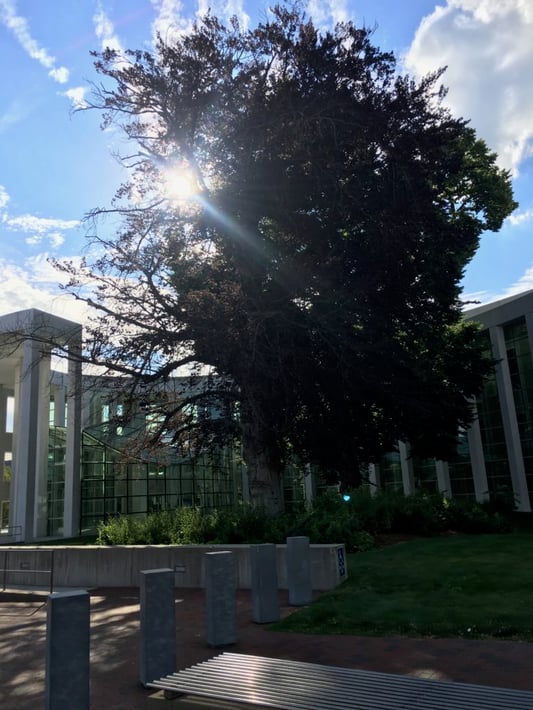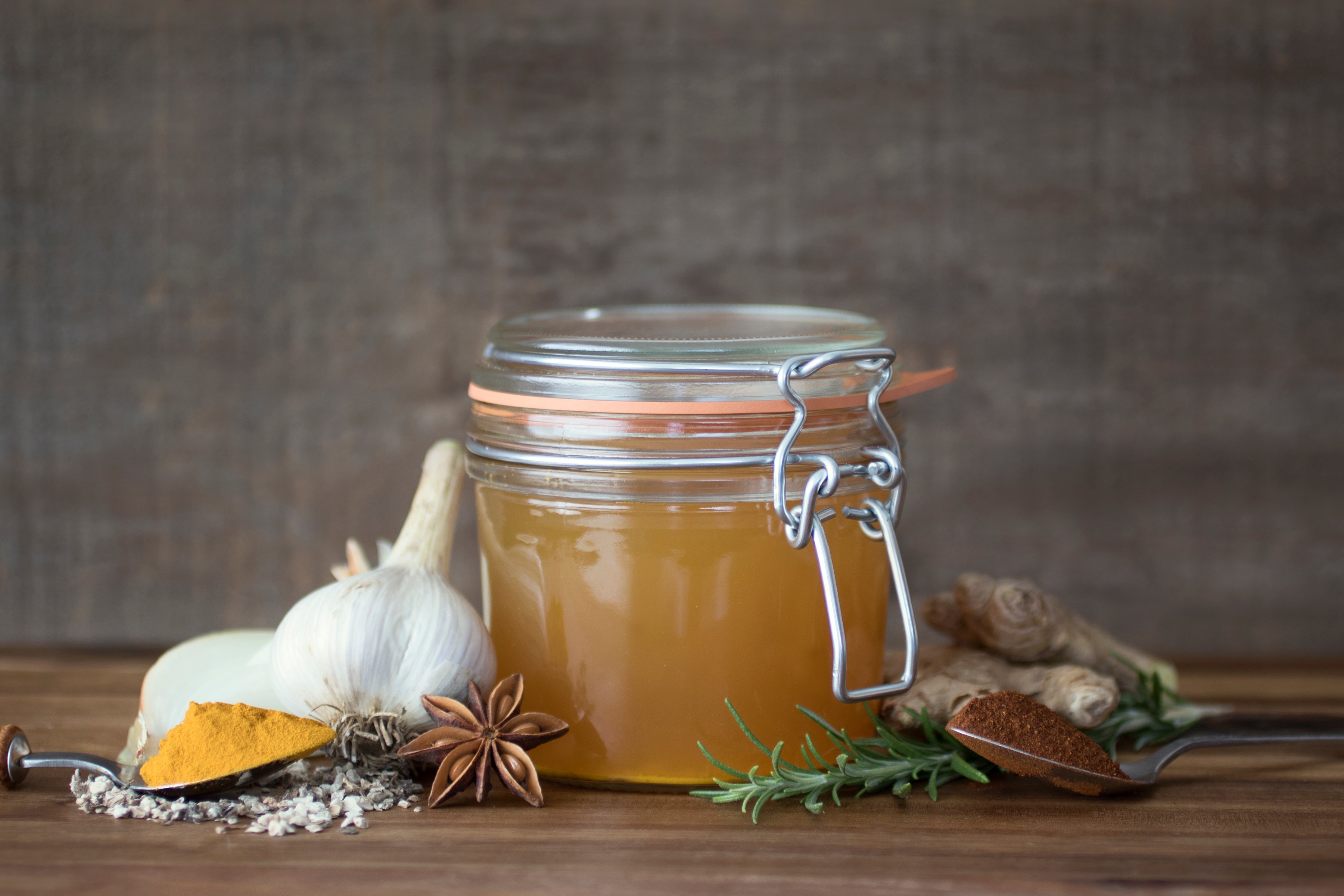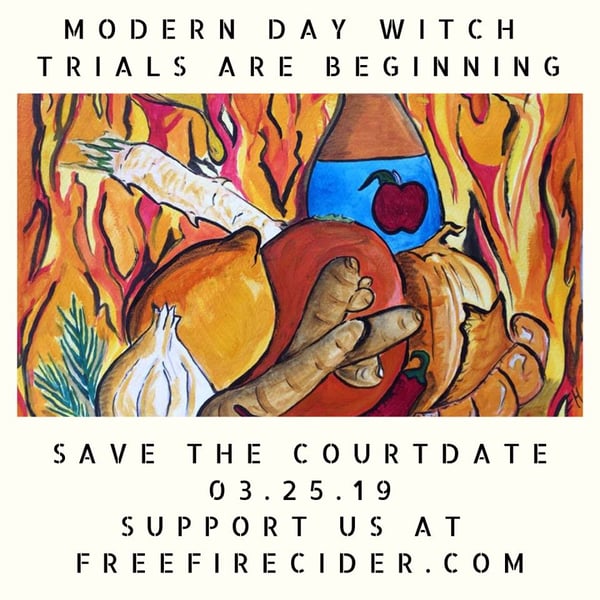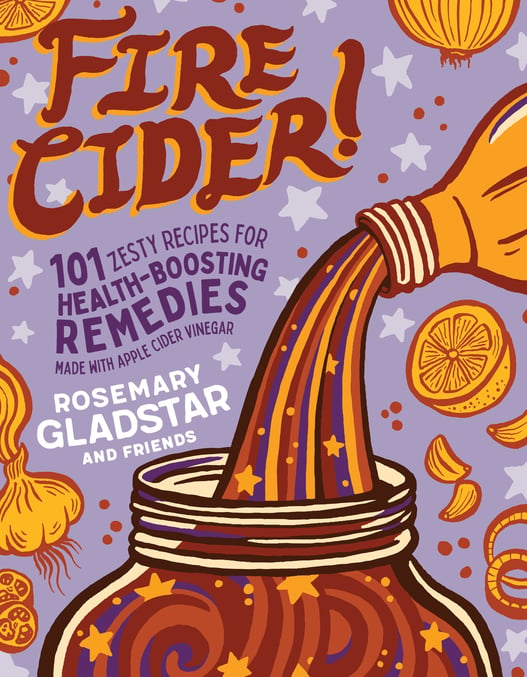
The Federal Courthouse in Springfield, Massachusetts is a large modern building with an entire edifice of glass facing the street. With its “cascading concave roof gracefully framing the space in a delicate shell of steel and glass,” the courthouse is an imposing sight. But even more impressive than this wall of steel and glass are the two ancient trees that the courthouse was obviously built to accommodate. The glass walls literally curve around a huge old copper beech that looks like it’s been standing there for centuries and the largest Tillia europa, or linden tree, that I’ve ever seen. It’s apparent that the architects took these trees into account when planning and building this courthouse. I later learned that indeed, the designers felt that “their presence was too powerful to ignore,” and the preservation of these trees “was a key element in the design proposal that emerged” for the courthouse.
The Fire Cider Three
Those two ancient guardian trees and the wild garden beneath them, replete with healthy stands of black cohosh and maidenhair fern, helped make our days in federal court bearable. Their beauty and strength rooted us deeply and gave us hope and courage, as did the community members who came out to support us during the seven days of trial. And the herbalists who brought us lunches that were spread picnic style in the courthouse pavilion, so that we’d have healthy food during the intensity of the trial. And the witnesses who traveled across the country to share their truth and tell their stories, all on their own dime and time. And then there were our amazing lawyers, who worked primarily pro bono for the past four years and poured not only their expertise, but also their hearts, into this case. But most of all, those trees were a bastion of strength for three young women who were on trial, like the witch hunts of old, for having the audacity to stand up for their herbal traditions: Nicole Telkes, Kathi Langelier, and Mary Blue, who have come to be known as the "Fire Cider Three." The Three spent four years preparing for this trial and seven exhausting days in federal court: all for a simple apple cider vinegar recipe aptly named “fire cider”.

The "Fire Cider Three" and Rosemary Gladstar prepare for a day of testimony. From left to right: Nicole Telkes, Mary Blue, Rosemary Gladstar, and Kathi Langelier.
The Original Fire Starters
Who would have thought a simple ACV recipe made from common kitchen ingredients would become as popular as it has, or as wildly controversial? It certainly never crossed my mind that day, a little over four decades ago, when I made that first auspicious batch of fire cider as part of a winter wellness class. Like most herbal recipes, it wasn’t fully original but rather was based on several other old folk remedies. I added my own touches, a few new herbs, a little something hot, and a little honey for sweetness. When my students and I strained and tasted that first batch of herb-infused vinegar several weeks later, a perfect merging of flavors exploded in our mouths. We knew we had created a winner, which we promptly and proudly dubbed “fire cider.”
And that’s how fire cider began, in the herb school kitchen of the California School of Herbal Studies somewhere between 1979 and 1980. It spread out into the world rather slowly at first, but as I traveled throughout the ensuing years and taught others how to make it, who in turn passed the formula onto others, it developed a life of its own and was soon spreading like, well, wildfire! While many people fell in love with the "original" recipe, others enjoyed customizing the blend to their own tastes, adjusting the herbs and adding a little more honey until it was just perfect for them. It was easy to make, inexpensive, and all of the herbs were readily available, easy to find in your own garden or the local supermarket. And best of all, not only was it tasty and easy to make, it was a very supportive remedy for many of those cold, damp conditions of winter. It was taken as a daily tonic to keep one hardy throughout the winter, was added to winter soups and salad dressings for an extra kick, and was diluted with a little warm water or warmed apple juice as an energizing winter drink.
It became one of many favorite recipes that I shared openly and freely with students and other herbalists. Soon enough, as happens with most popular recipes, others were making their versions of fire cider, and several started small companies that began selling fire cider at farmers’ markets, co-ops, and online sites such as Etsy. Herbalists often included fire cider as part of their class curriculum on herbs for winter health, and the recipe started popping up in herb books and in online courses and videos. It was one of those herbal remedies that people loved, made in their kitchens, traded, sold, and adapted. Everyone felt it was community property, to be claimed as one’s own, but belonging to everyone.
And that’s how the story should have continued but, unfortunately, it didn’t…
Trademarking Traditions
A little over five years ago, a young upstart company saw a business opportunity and proceeded to trademark the name "Fire Cider." It had never occurred to me, or to many others working within the plant medicine community, that a popular herbal remedy or a commonly used name could be trademarked. In our naiveté, we thought trademark laws were in place to provide protection for people who had created their own original products and/or names from others who were trying to copy them. We didn’t realize that, in fact, a trademark could sometimes be obtained by whoever grabbed the name and claimed ownership first. It was a wake up call.
Herbal remedies like fire cider have long been considered part of our "community owned" herbal legacy. Usually, this was because a recipe such as "four thieves vinegar" or "the queen of Hungary’s water" had been around for so long that ownership could no longer be traced, or because a remedy like elderberry syrup, echinacea tincture, or fire cider was so popular that it was considered generic. There are hundreds of herbal formulas that fall into this category.
However, with the trademarking of fire cider, suddenly everything changed. If all of these traditional herbal formulas became vulnerable to trademarking, the consequences of such a sea change could be momentous. It could mean that herbalists would no longer be able to sell traditional herbal products under their original names—the names they are best known by. And for the customers who have come to depend on these traditional herbal remedies, their choice of products would be limited to the one company—often a larger and more industrialized company—that was able to secure ownership of the trademark.
Unfortunately, this shift has already begun to happen and is of primary concern for many people involved in the natural food movement. Much like the appropriation of native and indigenous people’s healing traditions, arts, and artifacts, herbal traditions that have long been shared by cultures around the world are also being appropriated. Shortly after fire cider was trademarked, a popular essential oil company trademarked four thieves vinegar, another well-known traditional recipe that happens to be not decades, but centuries old. What does that mean? After five hundred years of being communally owned and shared, now only one company is allowed to sell this age-old recipe under its given name. Before the trademarking of four thieves vinegar and fire cider, one had the opportunity to purchase these locally made products at farmers’ markets, at local co-ops, through herbal mail-order catalogs, and online sites. Now, you have one choice of each product, and in both instances (four thieves and fire cider), the companies who bought the trademarks are not owned or run by herbalists. You don’t have to be a good herbalist to make a good herbal product, but it does help!
It was these concerns, and many more, which eventually brought fire cider and several members of the herbal community to that courthouse in Springfield.

Starting a Fire Fight
As beautiful as those trees were and worthy of a visit, legal action isn’t something any of us would have planned on. But oddly enough, the company that had decided they had the sole right to claim ownership of fire cider (although the recipe and name had been around for decades) decided to take legal action against the Fire Cider Three, filing a $100,000 lawsuit against them. Their claim: that these three herbalists were damaging their business and had violated trademark laws. Nicole, Mary, and Kathi, each well-respected community herbalists, farmers, avid activists, and supporters of traditional herbalism, had decided that something needed to be done. That it wasn’t okay that companies could come along and buy up the rights to popular herbal remedies that were already in existence and were considered community owned.
As spokeswomen for the movement that was forming around fire cider, we founded two organizations: Tradition Not Trademark and Free Fire Cider, two online resources dedicated to educating people about the issues surrounding the trademarking of traditional herbal products. The goal was to educate people as to why it’s important to keep these herbal treasures as legacy, "open-source" herbal products, available for everyone to make, use, and sell as they like. While the greater concern was all traditional herbal products, the poster child was fire cider.
Free Fire Cider called for a national boycott of the trademarked, branded fire cider and prompted people to make their own. The boycott secured over 9,000 signatures in the first few days. People cared. In the meantime, Mary and Nicole continued to sell their own brands of fire cider, which they’d been offering for years in their local co-ops and farmers’ markets, fully aware that doing so was a violation of the new trademark. Kathi re-branded her fire cider as Fire Tonic, but she was also sued, nonetheless.
My role? As the creator of the original recipe and name, I was invested in getting this popular remedy back into circulation for the entire herbal community. I worked closely with Nicole, Mary, and Kathi on the behalf of fire cider. We became close friends and often consulted with one another. When the lawsuit was filed, I wasn’t included because I hadn’t sold fire cider since the sale of my herb shop in the 1980s. Nevertheless, my deep personal investment in this tradition compelled me to take a stand for fire cider alongside these three women, no matter what happened.
A Witch Trial by Fire
It was never our intention to go to court over this. We had been hoping for a resolution through mediation, a compromise by which the company who had trademarked fire cider could continue to sell fire cider under their name while still allowing other smaller companies to sell it as well. Such a conclusion would echo the status of products like Sriracha hot sauce or elderberry syrup, where everyone would be a winner and enjoy a piece of the good old apple pie (another generic name sold and appreciated—not appropriated—by many companies and individuals). But that didn’t happen.
When the company filed the lawsuit against Mary, Nicole, and Kathi, we were all shocked and, quite honestly, frightened by the huge sum of money they were demanding—$100,000 in damages directed at each of the Fire Cider Three. Thankfully, that huge sum was dismissed early on during the first trial, but the second trial over the trademark was still pending. Though exhausted from that first round of litigation, our team was not willing to walk away without doing everything we could to bring fire cider back to the public. And that’s what brought us to State Street in the spring of 2019 where we discovered those huge guardian trees.
Court itself was interesting and intense. None of us had ever experienced anything quite like it, nor do we have plans to experience it again. We were all sworn in, examined, and cross-examined. We gave our testimonies, told our truth, and shared our stories. We were an awesome force, really. Witnesses that got up to testify on behalf of fire cider spoke clearly and passionately, from the heart, of their work as herbalists and their history making and selling fire cider. Several had sales receipts dating to the early '80s, confirming they had been selling this offering long before the trademark had gone into effect. Our expert key witnesses—Dr. Butters, a linguist, and Mark Blumenthal of the American Botanical Council and editor of the prestigious magazine Herbal Gram—presented convincing arguments for the case of fire cider being a generic name, one that should be free to be used by all. Our lawyers, Seth Coburn and Jim Goggin of Dana Verrill Law Firm in Maine, were simply amazing people. They really cared about the case and what it stood for. They understood what was at stake and were willing to devote endless hours at no pay to help preserve our traditional herbal recipes.
There were also those special moments between court sessions spent with herbal community members who came to support us and Traditions Not Trademarks during the trial. They brought food, cheered us on, and helped disperse the anxiety that comes with being in court. And when we stood beneath those ancient guardian trees, grounding ourselves and receiving their energy, they reminded us why we were fighting this strange battle and helped us draw strength from deep within the earth.
The Future of Fire Cider
The story is still unfolding. Unlike in the movies, where the judge steps out after a few tense moments and publicly announces the final verdict, federal court has a long, meandering process. First there are the court proceedings, which can take place over several months, followed a few weeks later by a debriefing between lawyers and the judge. Several weeks after that, the lawyers present their closing arguments to the judge, and then the judge has several weeks to think about it all and make a decision.
So for now, we wait. If the case were to be determined simply on truth—the truth of who first made fire cider, the truth of who was selling it first, the truth of where it originated, and the truth that it has been a popular herbal remedy for over four decades and is regarded as a traditional herbal legacy recipe—then the herbal community will certainly win. But trademark laws are slippery, and even the savviest trademark lawyer is never sure how a case will turn out.
However, no matter the outcome, we’ve won simply by standing strong for our herbal traditions. After all, they are some of the oldest traditions on the planet, and belong to all of us!
Keeping the Flame Alive
In another community effort to keep the story of fire cider alive and accessible to all, a new book, Fire Cider! 101 Zesty Recipes for Health-Boosting Remedies Made with Apple Cider Vinegar, will be hitting shelves in October of this year. It was written to help ensure that traditional herbal formulas (those recipes and remedies that have a long history of being used) are kept "free for all" to make, use, and sell as they choose. It’s a lively collection of recipes contributed by more than 70 herbal enthusiasts, with energizing versions including Black Currant Fire Cider, Triple Goddess Vinegar, Fire Cider Dark Moonshine, and Bloody Mary’s Fire Cider. Colorful asides, including amusing anecdotes and tribute songs to the Fire Cider Three, capture the herbal community's passionate desire to pass along the fire cider tradition.
So now it’s time to gather up the kids or the neighbors, a few kitchen herbs, a bottle of apple cider vinegar, and get chopping. It’s easy and fun! Remember when making your first or next bottle of fire cider (or any of the fabulous fun sassy recipes in this collection), that you are participating in the herbal healing arts, a tradition that goes back thousands of years. Welcome to the wonderful world of herbs—may it keep you strong, well, and joyful!
Want to Make your own version of fire cider at home?
Check Out Our Classic Fire Cider Recipe!
You might also enjoy:















